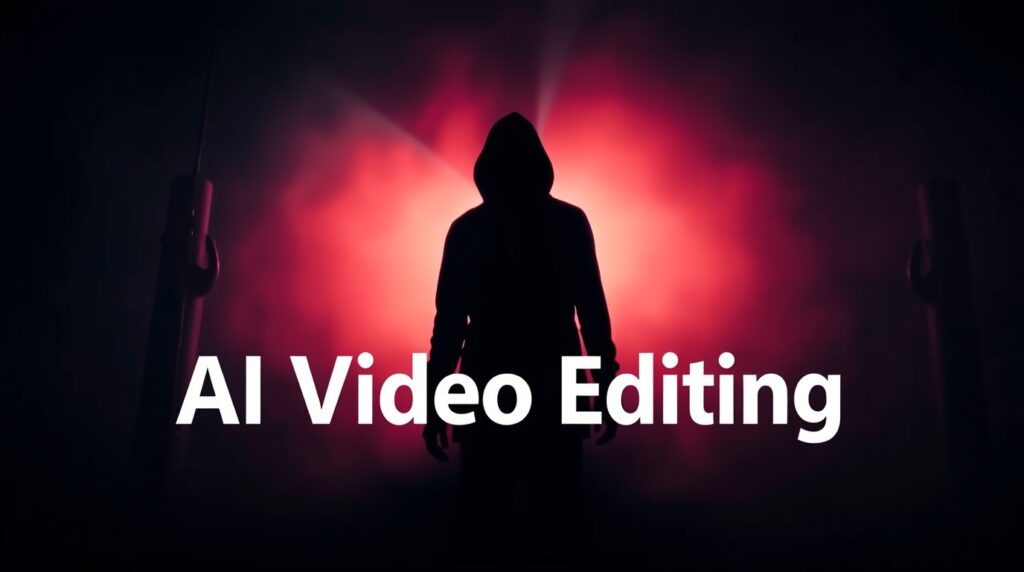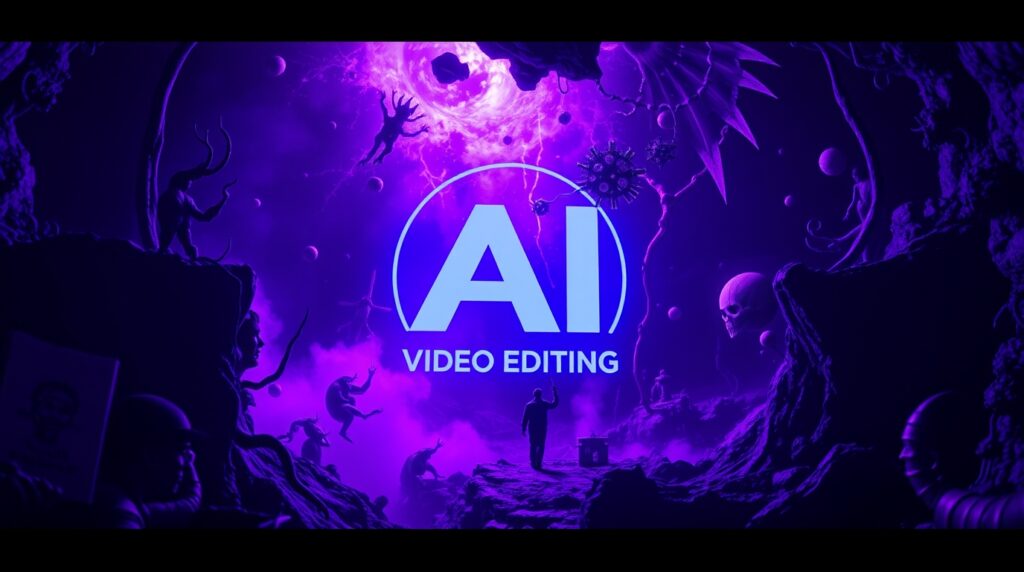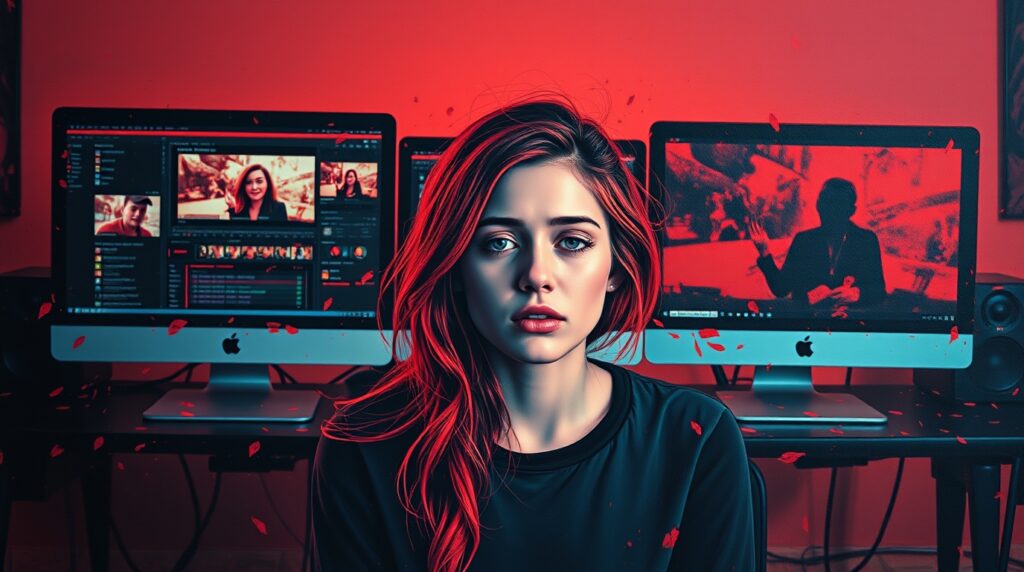Imagine never having to spend hours editing videos again. With the revolutionary advancements in AI technology, video editing has been completely transformed.
AI Video, an innovative video platform, utilizes AI to revolutionize the way videos are edited. From training videos to marketing videos, AI Video Editing provides seamless, efficient, and professional results. Say goodbye to tedious editing processes and say hello to the future of video editing with AI.

Introduction to AI Video Editing
What is AI Video Editing?
AI Video Editing refers to the use of Artificial Intelligence (AI) technology to automate and enhance various aspects of the video editing process. With AI, video editing tasks that typically required hours of manual labor can now be accomplished with greater efficiency and precision. AI algorithms are trained to understand video content, analyze it, and perform edits based on predefined parameters, resulting in a faster and more streamlined editing workflow.
Benefits of AI Video Editing
The adoption of AI Video Editing brings numerous benefits to video editors and content creators. Firstly, it significantly reduces the time and effort required for editing tasks. AI algorithms can automatically detect and remove unwanted sections, apply color correction, and even generate subtitles, eliminating the need for manual intervention in these processes.
Secondly, AI Video Editing tools provide a higher level of accuracy and consistency. With AI, you can ensure that each video produced adheres to the same editing standards, maintaining brand consistency and delivering a polished final product.
Thirdly, AI Video Editing tools offer a wide range of creative capabilities, allowing video editors to experiment with new effects and styles. Whether it’s applying filters, generating special effects, or adding custom visual elements, AI empowers editors to take their creativity to new heights.
Overall, AI Video Editing revolutionizes the way videos are edited by automating repetitive tasks, improving efficiency, maintaining consistency, and offering innovative creative possibilities.
AI Video Editing Tools
Overview of AI Video Editing Tools
AI Video Editing tools leverage advanced algorithms and machine learning techniques to automate various aspects of the video editing process. These tools analyze video content, identify key elements, and perform edits based on predefined criteria. From basic tasks like trimming and cropping to advanced tasks such as color correction and scene detection, AI Video Editing tools offer a comprehensive suite of features to streamline the editing workflow.
Popular AI Video Editing Tools
There are several popular AI Video Editing tools available in the market today. One notable example is Adobe Premiere Pro, which incorporates AI-powered features like automated scene detection, smart clip organization, and efficient video rendering. Other popular tools include Final Cut Pro, DaVinci Resolve, and Pinnacle Studio, all of which employ AI to automate various editing tasks and enhance productivity.
Features and Capabilities of AI Video Editing Tools
AI Video Editing tools come with a wide range of features and capabilities designed to simplify and enhance the editing process. These tools can automatically detect and remove unwanted sections, stabilize shaky footage, apply color correction based on predefined styles, and even generate subtitles and closed captions using automatic transcription. Additionally, AI-powered tools offer advanced special effects, filters, and visual enhancements that can transform the look and feel of a video.
By leveraging AI technology, video editing tools can deliver faster editing workflows, higher accuracy, improved creativity, and increased productivity for video editors.
Automated Video Editing with AI
How AI Automates Video Editing
AI automates video editing by leveraging machine learning algorithms and computer vision techniques. The algorithms are trained on vast amounts of video data and learn to recognize patterns, objects, and scenes within videos. This enables AI to automatically detect and remove unwanted sections, apply adjustments like color correction and noise reduction, and even generate subtitles and closed captions.
To achieve automated video editing, AI algorithms analyze the visual and audio components of a video, identify key elements, and make adjustments based on predefined parameters. By automating these repetitive and time-consuming tasks, AI significantly reduces the manual effort required for video editing.
Use Cases of Automated Video Editing
Automated video editing with AI finds application in various industries and use cases. For instance, in the entertainment industry, AI can be used to quickly edit and process large volumes of footage, saving time and cost in post-production. In the e-learning and training sector, AI-powered video editing enables the creation of interactive and engaging training videos by automatically adding visual effects and captions.
Moreover, AI-based automated video editing is valuable in marketing and advertising, where videos need to be produced and edited at scale. By automating tasks like scene detection and color correction, AI empowers marketers to create high-quality videos efficiently, enhancing brand image and customer engagement.
Benefits of Automated Video Editing
Automated video editing with AI brings numerous benefits to video editors and content creators. Firstly, it significantly reduces editing time and effort, allowing editors to focus on more creative aspects of their work. With AI handling tasks like scene detection and color correction, editors can devote more time to crafting compelling narratives and adding artistic touches to their videos.
Secondly, automated video editing ensures consistency in the editing process. AI algorithms follow predefined parameters, ensuring that all videos produced maintain a consistent style and meet brand guidelines.
Thirdly, automated video editing improves productivity by streamlining the editing workflow. By automating repetitive tasks, AI frees up time for editors to take on more projects or invest it in refining the quality of their work.
Overall, automated video editing with AI enhances efficiency, maintains consistency, improves productivity, and allows video editors to focus on their creative vision.
AI-powered Video Enhancement
Enhancing Video Quality with AI
AI-powered video enhancement techniques utilize machine learning algorithms to analyze and improve the visual quality of videos. These algorithms are trained on large datasets of high-quality videos and learn to identify and correct common issues such as blurriness, noise, and low resolution.
By leveraging AI, video enhancement tools can automatically adjust various parameters like sharpness, contrast, and color saturation to enhance the overall visual quality of a video. These tools are particularly useful for improving the quality of older or low-quality footage, making them look more professional and visually appealing.
AI-powered Color Correction
Color correction is an essential component of video editing that ensures consistent color representation across different shots and scenes. AI-powered color correction tools analyze the visual elements of a video and make intelligent adjustments to achieve the desired color grading.
AI algorithms can automatically detect and correct color imbalances, adjust brightness and contrast levels, and even apply stylistic color effects based on predefined styles. This not only saves time for video editors but also ensures a consistent and visually pleasing color representation throughout the video.
AI-driven Noise Reduction
Noise, such as grain or distortion, can degrade the visual quality of a video. AI-driven noise reduction techniques utilize machine learning algorithms to analyze the patterns and characteristics of noise in a video and intelligently remove or reduce it.
By leveraging AI, video editing tools can automatically identify and suppress various types of noise, resulting in a cleaner and more professional-looking final product. This is particularly beneficial for videos shot in low-light conditions or with lower-quality cameras, as AI-driven noise reduction can significantly improve the overall visual quality.
By leveraging AI-powered video enhancement techniques, video editors can easily improve the visual quality of their videos, ensuring a professional and visually appealing result.

Creative Video Effects with AI
Applying AI-driven Filters
AI-driven filters offer a wide range of creative possibilities for video editors. These filters use machine learning algorithms to analyze the visual content of a video and automatically apply various effects based on predefined styles or user preferences.
From vintage and retro looks to futuristic and artistic styles, AI-driven filters can instantly transform the visual aesthetics of a video. By automatically applying these filters, video editing tools powered by AI allow editors to experiment with different looks and styles, adding a unique touch to their videos.
Generating Realistic Special Effects
AI-powered video editing tools can generate realistic special effects that were once complex and time-consuming to create manually. By training on vast amounts of video data, AI algorithms have learned to understand the dynamics of objects and scenes, enabling them to generate sophisticated effects with ease.
Whether it’s adding explosions, creating realistic fire, or simulating natural phenomena like rain or snow, AI provides editors with the ability to easily incorporate visually stunning special effects into their videos. This opens up endless creative possibilities and allows for the production of high-quality videos with stunning visual effects.
Adding Custom Visual Effects
AI-enabled video editing tools also empower editors to add custom visual effects to their videos. By leveraging machine learning algorithms, these tools can analyze the video content and intelligently apply user-defined visual effects based on predefined parameters.
Whether it’s adding text overlays, graphical elements, or even applying animated visual effects, AI enables video editors to personalize their videos and create unique visual experiences. This level of customization enhances storytelling and enables content creators to captivate their audience with visually engaging videos.
AI-Assisted Video Transcription and Subtitling
Automatic Transcription of Video Content
AI-assisted video transcription utilizes speech recognition algorithms to automatically convert spoken words in a video into written text. These algorithms are trained on vast amounts of audio and video data, enabling them to accurately transcribe the speech in a video.
By leveraging AI, video editors can save significant time and effort in manually transcribing recorded dialogue or voiceovers. Automatic transcription not only speeds up the editing process but also ensures the accuracy of the transcribed text.
Generating Subtitles with AI
AI can automatically generate subtitles for videos based on the transcribed text. By analyzing the timing and content of the transcribed text, AI algorithms can synchronize the subtitles with the video, ensuring proper timing and alignment.
This automated subtitle generation saves editors the time and effort of manually creating subtitles for their videos. It also enhances accessibility by making videos more inclusive for viewers who are deaf or hard of hearing.
Improving Accessibility with AI Transcription
AI-assisted video transcription and subtitling greatly improve accessibility for all viewers. By providing accurate transcriptions and synchronized subtitles, AI enables individuals with hearing impairments or language barriers to enjoy the content fully.
Moreover, AI transcription facilitates better searchability and indexing of video content. The transcribed text can be used as metadata, enabling users to search for specific keywords or phrases within a video. This enhances the discoverability and reach of video content, benefiting both content creators and viewers.
AI-based Content Analysis for Video Editing
Content Understanding and Analysis with AI
AI-based content analysis tools offer advanced capabilities to understand and analyze the content of videos. Through machine learning algorithms, these tools can recognize objects, scenes, and even emotions depicted in the video.
By analyzing the content, AI can automatically detect and categorize different elements, enabling editors to make informed editing decisions. For example, AI algorithms can detect the presence of specific objects or emotions and trigger specific edits or effects accordingly.
Automated Scene Detection
Scene detection is a time-consuming task in video editing, requiring editors to manually identify and separate different shots or scenes. AI-powered video editing tools automate this process by analyzing the visual elements and transitions within a video to detect and divide it into distinct scenes.
Automated scene detection saves editors valuable time, allowing them to focus on more creative aspects of their work. It also enables faster navigation within a video and facilitates efficient content organization.
Smart Clip Organization
AI-powered video editing tools offer smart clip organization capabilities that enable editors to quickly search and organize their video footage. By analyzing the visual and audio elements of a video, AI algorithms can categorize and tag clips based on content, scene, object, or even dialogue.
This intelligent clip organization simplifies the video editing process, making it easier for editors to locate and utilize specific clips during the editing process. Additionally, it enhances efficiency by saving valuable time that would otherwise be spent manually organizing and searching for footage.
AI-enhanced Video Rendering
Efficient Video Rendering with AI
Video rendering, the process of converting edited video footage into a final playable format, often consumes significant time and resources. AI-enhanced video rendering techniques leverage machine learning algorithms to optimize the rendering process and improve efficiency.
By analyzing the content and characteristics of the video, AI algorithms can intelligently allocate system resources and optimize the rendering settings. This results in faster rendering times and increased efficiency, allowing editors to deliver their videos more quickly.
Reducing Rendering Time
AI-powered video rendering techniques can significantly reduce rendering time by intelligently optimizing the rendering settings. By analyzing the video content, AI algorithms can determine the optimal encoding parameters and allocate computing resources accordingly.
This reduction in rendering time allows video editors to complete their projects faster, meet tight deadlines, and deliver high-quality videos more efficiently.
Optimizing Video Compression
AI can also optimize video compression during the rendering process. By analyzing the content and characteristics of the video, AI algorithms can intelligently adjust compression settings to achieve the best balance between video quality and file size.
AI-enhanced video compression techniques help preserve the visual quality of the video while reducing file sizes, making it easier to share and distribute videos across various platforms and devices.
By leveraging AI in the video rendering process, video editors can save time, increase efficiency, and optimize the visual quality of their final videos.
AI-powered Workflow Automation
Streamlining Video Editing Tasks
AI-powered workflow automation simplifies the video editing process by automating repetitive and time-consuming tasks. By identifying patterns and applying predefined parameters, AI algorithms can automatically perform specific edits or apply effects to footage, freeing up editors to focus on more creative aspects of their work.
Tasks such as resizing, cropping, and applying standard edits or effects can be automated with AI-powered workflow automation, enhancing the speed and efficiency of the editing process.
Automated Video Editing Workflows
AI-powered workflow automation enables the creation of automated video editing workflows. These workflows can be designed to automatically perform specific tasks or apply predefined templates, thereby reducing the need for manual intervention.
For example, a workflow can be created to automatically analyze and categorize footage, apply color correction based on predefined styles, and generate subtitles using automatic transcription. This automation streamlines the editing process, enhances productivity, and ensures consistency in the final output.
Increasing Productivity with AI
AI-powered workflow automation significantly increases productivity for video editors and content creators. By automating repetitive tasks, AI frees up time that can be utilized for more creative endeavors or to handle a larger volume of projects.
Automated workflows also minimize the possibility of human error and ensure consistent results. This level of productivity enables content creators to optimize their resources and deliver high-quality videos more efficiently.
Future of AI Video Editing
Advancements in AI Video Editing
The future of AI Video Editing holds exciting possibilities for the industry. Continued advancements in AI algorithms and technologies will enable even more sophisticated and intelligent video editing capabilities.
Future AI Video Editing tools may offer enhanced scene detection, where algorithms can accurately identify different elements within a video, such as specific objects, faces, or emotions. This will open up new creative possibilities and further automate the editing process.
Additionally, AI is likely to play a larger role in pre-production, assisting in script analysis, storyboard creation, and even suggesting editing styles based on desired outcomes. This will streamline the entire video production process and enhance the collaborative nature of video editing.
Implications for Video Production Industry
AI Video Editing has significant implications for the video production industry. The adoption of AI tools and techniques will radically transform the way videos are created and edited. Video creators will be able to produce high-quality content more efficiently, enabling them to meet growing demands for video content across various platforms.
The increased accessibility and automation offered by AI Video Editing will lower barriers to entry for aspiring video editors and content creators. With AI automating repetitive tasks, aspiring editors can focus on honing their creative skills, leading to an influx of fresh and innovative content.
Furthermore, AI Video Editing will democratize the editing process, making it accessible to a wider audience. In turn, this will result in diverse content production, reflecting a broader range of perspectives and creativity.
Emerging Trends in AI Video Editing
Several emerging trends are shaping the future of AI Video Editing. One such trend is the integration of AI and machine learning technologies into cloud-based video editing platforms. This allows for real-time collaboration, automated backups, and seamless integration of AI-powered tools.
Another trend is the rise of AI-powered video analytics, where algorithms analyze audience engagement, sentiment, and consumption patterns. This data-driven approach will enable content creators to tailor their videos to specific audiences, increasing viewer engagement and driving better results.
Lastly, the integration of AI Video Editing with virtual reality (VR) and augmented reality (AR) technologies holds immense potential. AI algorithms can analyze and process VR/AR content, providing seamless editing and post-production capabilities for immersive experiences.
In conclusion, the future of AI Video Editing is marked by increased automation, enhanced creative possibilities, and improved efficiency. With continued advancements in AI algorithms and technologies, the video production industry is set to undergo a revolution, enabling video editors and content creators to push the boundaries of their creativity and deliver captivating videos to audiences worldwide.

